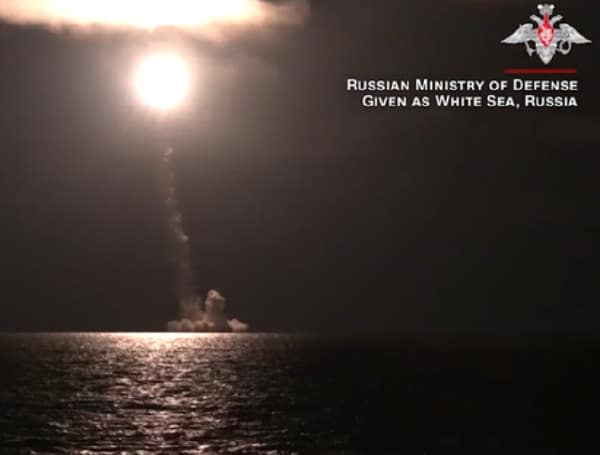The arrival of a U.S. nuclear submarine in the Middle East has sparked global interest and raised questions about the motives behind this strategic deployment.
The Ohio-class guided missile submarines, measuring 560 feet long and weighing 18,750 tons, are renowned for their formidable capabilities, including the capacity to carry up to 154 Tomahawk cruise missiles.
Normally, the movements of these submarines are kept top secret, but in a rare public announcement, US Central Command revealed that an Ohio-class submarine had recently reached the Middle East region.
In the midst of escalating tensions between Russia and the West, the Russian military announced the successful test launch of an intercontinental ballistic missile (ICBM) from a new nuclear submarine, the Imperator Alexander III.
This development comes on the heels of President Vladimir Putin’s decision to revoke Russia’s ratification of a global nuclear test ban.
Read: Irony Alert: Indianapolis Terrorist Crashes Into Building She Thought Was A Jewish School
The Significance of the Public Announcement
According to Jonathan Lord, Director of the Middle East Security program at the Center for a New American Security, the decision to publicly highlight the deployment of an Ohio-class submarine is highly unusual.
Lord suggests that this move reflects the US administration’s commitment to prevent Hezbollah and other actors from joining the conflict and opening new fronts against Israel. The announcement is seen as an indication that the US government still perceives a significant risk of wider conflict in the region.
Eric Brewer, a nuclear weapons policy expert at the Nuclear Threat Initiative, echoes this sentiment, stating that such deployments and messaging in the region would not occur unless there were valid concerns about escalation.
The range of the Tomahawk missiles carried by the Ohio-class submarines, coupled with their capabilities, suggests that the deployment is primarily focused on addressing threats in and around the Mediterranean.
However, it is worth noting that these missiles have the potential to reach targets far beyond northern Lebanon.
Russia’s Test Launch
The Russian Defense Ministry revealed that the Imperator Alexander III strategic missile cruiser successfully fired the Bulava missile from an underwater position in the White Sea.
The missile traveled thousands of kilometers and hit its designated target in Kamchatka, a far-eastern region of Russia.
The Borei-class submarines are a formidable addition to Russia’s naval arsenal.
These state-of-the-art submarines are equipped with 16 Bulava missiles each, capable of carrying nuclear warheads. With the Imperator Alexander III and three other submarines already in service, and one undergoing testing, Russia is rapidly expanding its nuclear capabilities.
Additionally, three more Borei-class submarines are currently under construction.
Implications for Russia’s Nuclear Strategy
Russia’s recent actions, including the test launch and the revocation of the global nuclear test ban, highlight its determination to maintain and strengthen its nuclear capabilities.
These developments are seen as a response to perceived threats from the West and a way to assert Russia’s position on the global stage.
By showcasing its advancements in nuclear technology, Russia aims to establish itself as a formidable force in international affairs.
Read: Trump Rips Iowa Governor On Possible DeSantis Endorsement “End Of Her Political Career”
Geopolitical Ramifications
The test launch of an ICBM and the expansion of Russia’s nuclear submarine fleet have far-reaching geopolitical implications.
The growing assertiveness of Russia’s nuclear forces adds complexity to an already tense relationship between Russia and the West.
It raises concerns among Western nations about the balance of power and the potential for a new arms race. As a result, diplomatic efforts to mitigate these tensions become even more critical.
Escalating Tensions in Ukraine
The timing of Russia’s nuclear advancements is significant, given the ongoing conflict in Ukraine.
Tensions between Russia and the West have reached a boiling point, with Russia’s annexation of Crimea and its support for separatist movements in eastern Ukraine.
The test launch and the revocation of the nuclear test ban further exacerbate these tensions, leaving diplomatic solutions in question.
The Importance of Parity with the United States
Russia’s decision to revoke its ratification of the global nuclear test ban is justified by the need to establish parity with the United States.
Russia perceives itself as being at a disadvantage in terms of nuclear capabilities and seeks to level the playing field. By showcasing its technological advancements,
The Future of Russia’s Nuclear Forces
With the Borei-class submarines becoming the core naval component of Russia’s nuclear forces, it is evident that Russia is investing heavily in its nuclear capabilities.
The expansion of its submarine fleet, coupled with advancements in missile technology, signifies Russia’s long-term commitment to maintaining a robust nuclear deterrent. As these submarines are fully integrated into the fleet, Russia’s nuclear posture will be further strengthened.
International Response and Arms Control
Russia’s recent actions have raised concerns among the international community. The United States and its allies closely monitor Russia’s nuclear advancements and assess their implications for global security.
The need for arms control and disarmament agreements becomes more pressing in light of these developments. Diplomatic efforts to engage Russia in dialogue and negotiate arms control measures are crucial to maintaining stability and avoiding a new arms race.
Android Users, Click To Download The Free Press App And Never Miss A Story. Follow Us On Facebook and Twitter. Signup for our free newsletter.
We can’t do this without your help; visit our GiveSendGo page and donate any dollar amount; every penny helps

